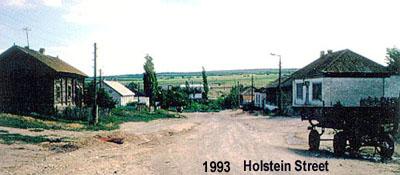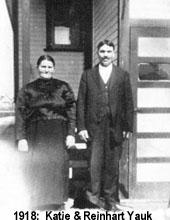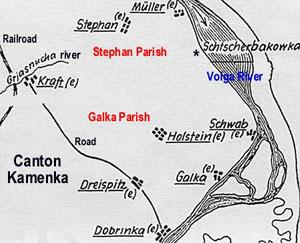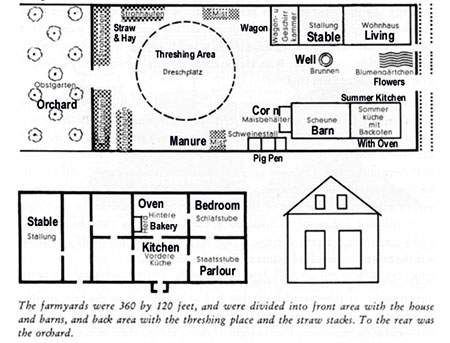

| The Lower Volga
Villages:(Saratov,
Volga, Russia)
For 177 years, between 1764 and 1941, there existed along the west side (Bergseite) of the lower Volga River in Russia, a cluster of nine colonies populated by Germans of the Lutheran faith. They were among the 104 original colonies founded between 1764 and 1767. The table below lists the villages most associated with our Yauk family who migrated from Germany to Russia around 1767 (Census 1798). Since farm land allotted to each village was fixed with boundaries touching each other, it eventually became necessary to develop Daughter colonies. These were usually built on the East side (Weisenseite) of the Volga. |
 |
|
|
|
|
|
German - Russian |
| Holstein - Verkhnaya Kulalinka - Our Yauk Family | Kraft - Verkhnaya Grasnucha |
| Dobrinka - Niznyaya Dobrinka | Mueller - Krestovok Bujerak |
| Dreispitz - Verkhnaya Dobrinka - Other Yauks | Shcherbakovka - Muehlberg |
| Galka - Ust Kalalinka | Stephan - Vodyanoi Bugerak |
| Schwab - Buidakov Bujerak | Oberdorf - Other Yauks (daughter-colony) - Kupzowo |
 |
Most villages were established on the Volga River or upstream on brooks
which ran into the Volga. Holstein was located on a small upper stream
called Kulalinka which flowed into the Volga at Galka.
Note: Kulalinka = name of stream; Verkhnaya = up-stream; Niznyaya = down-stream. Holstein is our Yauk Family village but does not exist anymore except for a few dwellings and people. In 1904, the church had 2434 members and the school had 231 students of which the older kids of Reinhart and Katie would have attended. Katherine, my mother, was only 5-6 months old when they emigrated to Canada. |
|
The graves in this picture are in the background. However Reinhart's house was destroyed as observed in 1956 by a returning Kuxhaus. Photo taken 1993 |
 |
| House and Garden: (Stumpp &
Giesinger)
In the Volga region were block houses of the simplest type: smooth logs of fir or pine were squared off, mounted, and chinked with clay, to form a "log cabin" 24 to 30 feet long and 20 feet wide. Better homes were built later, still made of wood, but they were larger and their external appearance indicated prosperity. Holstein like all villages consisted of house-farms, called farmyards, which were ordered in checkerboard streets. Each farm yard was divided into a front yard and a back yard. At the side of the street in the front yard stood the house and the bake house (summer kitchen). Sometimes next to the house was the courtyard door (called the "little courtyard door") and the courtgate. |
| On both of the long sides stood sheds and agricultural buildings. The
front yard closed with the stalls for the large animals. The stalls for
small animals and the manure piles were in the back yard. Several details
can be taken from the sketch. Every back yard connected to the garden.
As can be seen from the sketch, the garden of the yard of two streets connected
together.
Almost everywhere the colonist house had a somewhat similar floor plan. From the entrance one came into a hallway which led to the kitchen. On either side were living quarters; on the street side were located the living room ("Staats-stube") and the master bedroom; on the corresponding left side were front and rear bedrooms. The floors were of wood and the walls were covered with patterned wallpaper or painted. |
 |
| Almost all the houses in the Volga had only one story, with two stories built in the larger settlements. The yards were all laid out according to the plan approved by the administrative authorities: 90 to 120 feet wide and 240 to 360 feet long. The front area of the farmyard contained the dwellings, flower garden, summer kitchen, and the well; the back area contained the threshing floor, the straw stacks, manure piles, and the hog barns. In the summer, activities were centered in the summer kitchen. Here the womenfolk cooked and served the meals, made butter and cheese, and baked the tasty peasant bread in an oven fired with straw or wood prunings. |
| Note: We
know from the 1798 census that some Yauks had immigrated from Germany to
Holstein, Russia. Unfortunately the records for Holstein were destroyed
and Reinharts ancestors remain unknown. I checked this with Prof. Pleve
of Russia with a return message of:
establish names, interesting for you, it is impossible. Sincerely, Igor Pleve |
|
1798 Holstein Census: Albrecht, Asmus, Beichel, Beiler/ Peller, Beitz, Borger, Brehmer, Breiniger, Bruckman, Burger, Busch, Buxbaum, Dahn, Deisner, Dietrich, Eberhard / Eberhardt, Feiler ?, Frischler, Fritzler, Gantner, Geinitz, Gelbach, Gergenson, Graf/ Graff, Grauberger, Greb / Grabb / Kreb, Grund, Gunter / Gunther, Hiltermann, Jung, Kaiser, Kamich?, Kareten?, Kerbs, Kindsvater, Klein, Knaus, Koch, Kolln, Krebs, Kreutz, Kreitzfeld, Krenz / Krentz, Kugel?, Kuxhausen, Lotz?, Lutz, Mader, Mai, Malzer, Martin, Meder?, Meier, Meng, Michael, Mill/Muhl, Ogain?, Oheim, Pazor, Peil, Pfaff, Pomerinka ?, Pomrenke, Rau, Reicher, Reichert, Reisig / Reissig, Reister, Rilke / Rielke, Ruddel, Ruf / Ruff, Salzman / Saltzman, Sauerwein, Schafer / Schaffer, , Scherr, Scherer / Scherrer, Schick, Schiffelbein, Schmies, Schneider, Schrag, Schrauk?, Schwien, Seifert / Seiffert, Sinner, Stahldecker, Stehlfeld, Steinert, Steiwer, Stenkel, Vogler, Walter, Wasemiller / Wassemiller / Wassenmiller, Weber, Weiler, Wiedman/ Wiedeman / Wiedemann, Winik, Wink, Winter, Wittman, Yauk / Yauck |
|
|